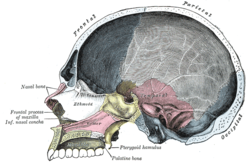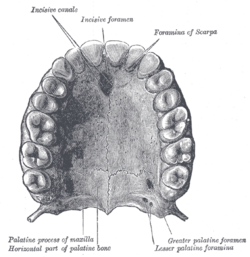Palatine bone
| Palatine bone | |
|---|---|

Sagittal section of skull. (Palatine bone is labeled at bottom left.)
|
|

Permanent teeth of upper dental arch, seen from below. (Horizontal part of palatine bone visible at bottom.)
|
|
| Details | |
| Identifiers | |
| Latin | Os palatinum |
| MeSH | A02.835.232.781.324.502.660 |
| TA | A02.1.13.001 |
| FMA | 52746 |
|
Anatomical terms of bone
[]
|
|
The palatine bones (/ˈpælətaɪn/) are two irregular bones of the facial skeleton in many animal species. Together with the maxillae they comprise the hard palate. (Palate is derived from Latin palatum which is unrelated to palatium 'palace', from which other senses of palatine derive).
The palatine bones are situated at the back part of the nasal cavity between the maxilla and the pterygoid process of the sphenoid bone.
They contribute to the walls of three cavities: the floor and lateral walls of the nasal cavity, the roof of the mouth, and the floor of the orbits. They aid in the formation of the pterygopalatine and pterygoid fossæ, and the inferior orbital fissures.
Each palatine bone somewhat resembles the letter L, and consists of a horizontal plate and a perpendicular plate and three outstanding processes—viz., the pyramidal process, which is directed backward and lateral from the junction of the two parts, and the orbital and sphenoidal process, which surmount the vertical part, and are separated by a deep notch, the sphenopalatine notch. The two plates form the posterior part of the hard palate and the floor of the nasal cavity; anteriorly, they join with the maxillae. The two horizontal plates articulate with each other at the posterior part of the median palatine suture and more anteriorly with the maxillae at the transverse palatine suture.
...
Wikipedia
